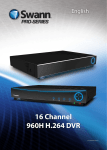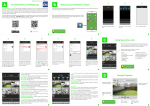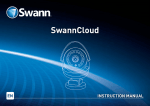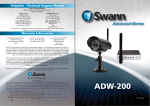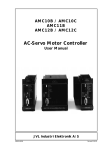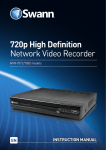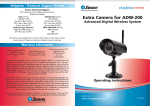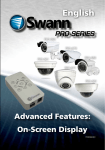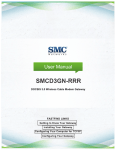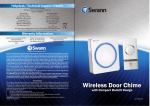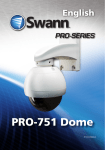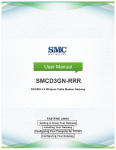Download 7300 Series 4 / 8 / 16 Channel User Manual
Transcript
PLATINUM DIGITAL HD Network Video Recorder INSTRUCTION MANUAL 1 Contents Chapter 1: Live View 3 Chapter 5: Playback & Backup26 Live View: 4 & 8 Channel4 Search: Playback27 Live View: 16 Channel5 The Playback Interface28 Chapter 2: Menu6 Search: Event30 Menu Layout7 Search: Backup31 Chapter 3: Camera Configuration8 Chapter 6: System Configuration32 IP Channel9 System: General33 Display: Camera10 System: User34 Display: Camera - Mask12 System Maintenance35 Display: Camera - Camera Parameter 13 Alarm: Exception36 Recording: Encode15 Device: HDD37 Alarm: Motion16 Display: Output38 Motion Detection17 Network: General39 Motion Detection Alarm Schedule18 Network: Advanced40 Motion Detection Tips19 Chapter 7: System Status41 Alarm: Video Loss20 Search: Log Search42 Video Loss Schedule21 Network: Status43 Chapter 4: Recording Configuration22 Device: S.M.A.R.T44 Recording: Encode23 System: System Information45 Recording: Option24 Important Information46 Recording: Schedule25 Warranty Information47 2 Live View Live View is the default display mode for the NVR. Each camera connected will be displayed on-screen. You can check the status or operation of your NVR and cameras using the icons and Menu Bar on the Live View screen. Right-click the mouse to access the Menu Bar. 09/12/2014 10:30:15 Tue 09/12/2014 10:30:15 Tue Camera1 09/12/2014 10:30:15 Tue Camera2 09/12/2014 10:30:15 Tue 09/12/2014 10:30:15 Tue Camera2 3 Live View: 4 & 8 Channel 09/12/2014 10:30:15 Tue Status Icons Camera1 Camera2 09/12/2014 10:30:15 Tue Menu Bar 1 1. Opens the Menu. 2. Click to view a single camera. 3. Click to view four cameras. 4. Click to view eight cameras. Double-click a live video channel to view full screen. 09/12/2014 10:30:15 Tue Camera Toolbar 09/12/2014 10:30:15 Tue 2 3 4 5 6 7 8 9 5. Click to view nine cameras. 8. Click to manually record the se6. Click to view the next screen in lected camera. single or four camera view. 9. Click to access the Setup Wizard. 7. Click to enable PIP mode. 4 Live View: 16 Channel 09/12/2014 10:30:15 Tue Status Icons Camera1 Camera2 09/12/2014 10:30:15 Tue Menu Bar 1 Double-click a live video channel to view full screen. 09/12/2014 10:30:15 Tue Camera Toolbar 09/12/2014 10:30:15 Tue 2 3 4 5 6 7 8 9 10 1. Opens the Menu. 6. Click to view sixteen cameras. 2. Click to view a single camera. 7. Click to view the next screen in 10. Click to access the Setup Wizsingle or four camera view. ard. 3. Click to view four cameras. 4. Click to view eight cameras. 5. Click to view nine cameras. lected camera. 8. Click to enable PIP mode. 9. Click to manually record the se- 5 Menu The Menu is where you control the various actions and options that are available on the NVR. You can also access previously recorded video for playback and to export to a USB flash drive or hard drive. To maintain system integrity, a firmware upgrade can be performed when available and access to the shutdown menu to restart or safely turn off the NVR. 6 Menu Layout The various actions and options that are available, are categorised on the left-hand side of the Menu. Clicking each category will reveal a number of tabs or sub-categories that can be changed from their default value. To exit or access the previous menu, rightclick the mouse To shutdown, reboot or lock the NVR, click the “Shut Down” button. To ensure the integrity of your data and recordings, always select “Shutdown” when powering off the NVR. Some options may have additional menus that can be accessed. 7 Camera Configuration The majority of the camera configuration options available are in the “Display”, “Recording” and “Alarm” menus that are accessible from the Menu. You can change the resolution and bitrate settings as well as the image settings for brightness, contrast and more. The NVR has several controls for motion detection and video loss and the ability to apply one or more masks for privacy. 8 IP Channel The IP channel function displays a list of cameras that are either connected directly to the NVR, or connected directly to your network. The name, IP address, channel number, status, user name and password of each camera is displayed. It’s not necessary to change the camera’s user name and password. Auto Add: This option is enabled by default. The NVR will automatically detect and display cameras connected directly to the NVR, or connected directly to your network. Scan: Click this button to update the list of cameras detected. • Don’t forget to click “Apply” to save settings. • Click “Cancel” to exit. 9 Display: Camera The configuration options available allow you to name each camera relevant to where it has been installed as well as the ability to adjust image settings such as brightness and contrast. You also have complete control of the camera’s display capabilities. Camera No.: Select a camera that you would like to configure. Hovering the mouse over the selection box will display the IP address and MAC address of the camera selected. The green icon indicates that a camera is connected to that particular channel. A red icon indicates that a camera is not connected to that particular channel. Camera Name: Select a name for the camera you’ve selected. It can be up to 16 characters in length. Display Camera Name: Leave this enabled if you would like to display the camera name on the Live View screen, otherwise click to disable. Record Date: It’s recommended to leave this enabled as the date will be recorded directly onto your videos and creates an inseparable record of exactly when the footage was captured. OSD Display Position: Allows you to change the position of the camera name on the Live View screen. Click the “Set” button to change. Use the mouse to reposition the camera name. Right-click the mouse then click “Save” to exit. Image Settings: This gives you access to the image adjustment tools. Click the “Set” button to change then click “OK” when finished. Brightness: This changes how light the image appears to be. Contrast: This increases the difference between the blackest black and the whitest white in the image. Saturation: This alters how much colour is displayed in the image. The higher the saturation, the more bright and vivid colours will appear. Hue: This changes the colour mix of the image. 10 Display: Camera (cont.) Sharpen: Increase or decrease the overall sharpness of the image. Increasing the sharpness will also increase the level of video noise that is visible. Mask: See page 12 for more information. Camera Parameter: See page 13 for more information. • Click the “Default” button to revert back to default settings. • Use the “Copy to” button to apply all settings to the other cameras. • Don’t forget to click “Apply” to save settings. • Right-click the mouse to exit the Menu. 11 Display: Camera - Mask A mask can be used if you want to obscure part of your image for privacy. You can also use this option to minimize false triggers for motion detection. You can define up to four areas per camera to mask. Any area obscured by a mask won’t be shown live or recorded. 09/12/2014 10:30:15 Tue Camera1 Mask: Click the checkbox to enable then click “Area Settings” to define one or more masks. 1: Using the mouse, click and drag to select the area that you want to enable for a mask (as shown above). Up to four masks can be enabled. 2: To delete a mask, move the arrow within the mask, right-click the mouse to access the sub-menu (as shown above) then click “Delete Area”. Click “Delete All” to delete all masks. Click “Save” to save your mask or click “Cancel” to exit. • Click the “Default” button to revert back to default settings. • Use the “Copy to” button to apply all settings to the other cameras. • Don’t forget to click “Apply” to save settings. • Right-click the mouse to exit the Menu. 12 Display: Camera - Camera Parameter 09/12/2014 10:30:15 Tue Camera2 Camera Parameter: This function gives you complete control on every aspect of the camera’s display capabilities. Click the “Set” button to change. Exposure Mode: This function determines how light or dark an image will appear on-screen. If there is very little light, the image will be underexposed. If there is too much light, the image will be overexposed - Anti-flicker: This function is used to reduce flicker caused by fluorescent lighting. If the video is flickering or you are mounting the camera outdoors, select the relevant option, otherwise leave it off - Auto: The exposure level is handled automatically. OFF: Anti-flicker is turned off. Anti-smearing: This function allows objects to be seen against a very bright background. Outdoor: Select this if the camera will be mounted outdoors. It’s designed to adjust the image for sunlight conditions. 50HZ: The UK and Australia utilise 50Hz for their mains frequency. 60HZ: The USA, Canada and some Latin American countries utilise 60Hz for their mains frequency. Low Noise: This function is used for night video. By increasing the gain range, you can decrease the video noise to gain a brighter image. Manual: This function allows you to manually adjust the shutter speed. Slowing down the shutter speed allows more light into the camera producing a brighter image. The potential downside is that you get more motion blur. 13 Display: Camera - Camera Parameter (cont.) 09/12/2014 10:30:15 Tue Camera2 Contextual: This function changes the way the camera processes white balance to correct image colours - CDS: This allows the image to be set by the camera’s light sensor. Auto: The white balance is handled automatically. OFF: The backlight is turned off. Day: Select this for daytime monitoring. Night: Select this for night time monitoring. Manual: This function will increase or decrease the red and blue gain. Day/Night: This function changes the camera’s colour mode during different times of the day AGC: This function allows an increase in sensitivity, enabling operation in lower light conditions. Colour: Select this for daytime monitoring. Black&White: Select this for night time monitoring. Backlight: Compensate for differences between dark and light objects BLC: This improves exposure of an object that is in front of a light source. WDR: This will brighten dark areas and darken bright areas. Mirroring: Click the checkbox to change the orientation of the image. Rotation: Click the checkbox to turn the image upside down. 3D-Noise Filter: This function will reduce the overall noise content. • Click the “Default” button to revert back to default settings. • Don’t forget to click “Apply” to save settings. • Click “Cancel” to exit. 14 Recording: Encode The encode function allows you to change the resolution and bitrate for each camera connected. By default the main stream resolution is “2048 x 1536” at 25fps which fits in with the capabilities of the provided cameras. The sub stream resolution is “CIF (352 x 288)”. Camera No.: Select a camera that you would like to configure. Encoding Parameters: Select which parameter that you would like to configure, main stream or sub stream. By default, the SwannView Link app and Windows software utilises the sub stream parameter to display an image from the NVR to your mobile device or computer. Record Audio: See page 23 for more information. Resolution: The default resolution is 2048 x 1536 for main stream. For sub stream the default resolution is 352 x 288 (CIF) but can be changed to 640 x 360. Max. BitRate(Kbps): The default bitrate is 5120Kbps for main stream and 64Kbps for sub stream. Change the bitrate if you’re having issues streaming to your mobile device or computer. • Click the “Default” button to revert back to default settings. • Use the “Copy to” button to apply all settings to the other cameras. • Don’t forget to click “Apply” to save settings. • Right-click the mouse to exit the Menu. Frame Rate(fps): The default frame rate is 25fps for main stream and 4fps for sub stream. Change the frame rate if you’re having issues streaming to your mobile device or computer. 15 Alarm: Motion Whether you’re waiting for an expected event, hoping you don’t spot an unwelcome visitor, or just curious about what happens when you’re not around, motion detection can be configured to alert you and record video only when it detects motion. Motion detection is enabled by default. Channel: Select a camera that you would like to configure. Enable: Motion detection is enabled by default. Motion Detection: Click the “Set” button to change the default motion detection area. See page 17 for more information. Schedule: Click the “Set” button to change the default motion detection alarm schedule. See page 18 for more information. Action: Click the “Set” button to enable an audio warning, to send an email and to trigger other cameras when motion is detected. • Click the “Default” button to revert back to default settings. • Use the “Copy to” button to apply all settings to the other cameras. • Don’t forget to click “Apply” to save settings. • Right-click the mouse to exit the Menu. 16 Motion Detection 09/12/2014 10:30:15 Tue Camera1 Using the “Sensitivity” function, you can change the motion sensitivity level for each time period available. The level is controlled by a slider, allowing you to set a value between 0 and 50. The lower the number, the more sensitive the motion detection will be. Motion detection is an essential part of your security system. It’s the main method that detects when someone is in your home when they shouldn’t be. When motion has been detected by one or more cameras, a signal is sent to your NVR, alerting you to a potential threat in your home. It does this in several ways such as activating an audio warning using its internal buzzer, sending an email and sending an alert to your smartphone or tablet. You can also configure your NVR so it triggers the other cameras to start recording. 1. Right-click the mouse to access the sub-menu then click “Delete All”. 2. Click and drag to select the area that you want to create a zone for. Multiple zones can be created. The same action also applies if you want to delete a zone that has been created. Motion detection is the default recording mode for the NVR. The entire view of the camera is enabled to detect motion however you can select certain areas if you wish. In the above example, a motion detection zone has been setup for the windows and dining room entrance. Movement outside of these zones will not be detected. • Click the “Default” button to revert back to default settings. 3. You can adjust the sensitivity level (see above) if required. 4. Right-click the mouse to access the sub-menu then click “Save” to save any changes that you have made. To revert back to default settings click “Add to All” or click “Cancel” to exit. • Use the “Copy to” button to apply all settings to the other cameras. • Don’t forget to click “Apply” to save settings. • Right-click the mouse to exit the Menu. 17 Motion Detection Alarm Schedule By default, a motion detection alarm schedule has been enabled for each connected camera. You can however change the schedule according to what fits in with your needs. The schedule is presented as a 24 hour 7 days a week grid and is colour coded to represent the event type. In the above example, a schedule has been created for 06:00 a.m. to 06:00 p.m. Sunday to Saturday. Using the mouse, click on a particular square or section to change. • Click the “Default” button to revert back to default settings. • Don’t forget to click “Apply” to save settings. • Click “Cancel” to exit. • Right-click the mouse to exit the Menu. 18 Motion Detection Tips Placement of the cameras Bedroom Backdoor 1. Keep cameras 10 - 15 feet (3 - 4 metres) away from heating vents, where the sunlight shines in, and radiators. If a camera detects a swift change in motion, even that of a cloud passing quickly over direct sunlight shining into your living room, motion detection could be activated. 2. Place cameras in areas where people have to walk through, like the stairwell, main hallway or entry door. That way, an intruder will activate motion detection regardless of where they are headed. Intruders usually go right for the master bedroom, so put a camera near that room or other rooms where you have valuables, like the study. 3. Walk through your house and assess where intruders are most likely to enter, and what path they would take. Most burglars enter the home through a front or back door, so it’s advisable to place the cameras near those areas. Hallways 4. When installing cameras outside, it’s important to keep your front and backyard well-lit for ideal night vision and motion detection. It’s common for intruders to enter a home through an unlocked garage or by using a garage door opener in an unlocked car located in the driveway. Avoiding False Triggers 1. A flag or foliage that is blown by the wind - Angle the camera so wind-blown objects are out of the camera’s view. Frontdoor 2. Pets moving in front of the camera - Lower the sensitivity level and/or point the camera into areas that are not particular high-traffic for your pets. 3. Vehicles moving in the background - Angle the camera so as to avoid movement in the background. 4. Moving air from a heater or air conditioner - Angle the camera away from heater and air conditioner sources. 5. Movement reflected off smooth surfaces such as glass - Lower the sensitivity level and/or avoid pointing the camera directly at glass surfaces. 19 Alarm: Video Loss Video loss is regarded as a potential alarm event and is considered to occur any time the NVR doesn’t receive an active video signal from any of its video inputs. When a video input has no incoming signal, a “VIDEO LOSS” message will appear on-screen. Channel: Select a camera that you would like to configure. Enable: Click the checkbox to enable. Schedule: Click the “Set” button to change the default video loss alarm schedule. See page 21 for more information. Action: Click the “Set” button to enable an audio warning and to send an email. • Click the “Default” button to revert back to default settings. • Use the “Copy to” button to apply all settings to the other cameras. • Don’t forget to click “Apply” to save settings. • Right-click the mouse to exit the Menu. 20 Video Loss Schedule In the above example, a schedule has been created for 06:00 a.m. to 06:00 p.m. Sunday to Saturday. Using the mouse, click on a particular square or section to change. • Click the “Default” button to revert back to default settings. • Don’t forget to click “Apply” to save settings. • Click “Cancel” to exit. • Right-click the mouse to exit the Menu. 21 Recording Configuration The recording configuration options are available in the “Recording” menu that is accessible from the Menu. From here you can access and change the recording schedule for each camera connected as well as how the NVR will record video to the hard drive. You can also enable audio recording from the camera’s built-in microphone. 22 Recording: Encode Record Audio: Click the checkbox to enable audio recording from the camera’s built-in microphone. To monitor what is being recorded, the NVR’s audio output has to be enabled. See page 38 for more information. • Click the “Default” button to revert back to default settings. • Use the “Copy to” button to apply all settings to the other cameras. • Don’t forget to click “Apply” to save settings. • Right-click the mouse to exit the Menu. 23 Recording: Option The options available here allow you to change various aspects of how the NVR will record video, such as recording before and after an event has occurred as well as the ability to record over existing video, to make room for new events on the hard drive. Overwrite: This option allows the NVR to overwrite the oldest video files on the hard drive when recording. This prevents the NVR from running out of storage space. It’s recommended to this option enabled and to backup important events before they are overwritten. • Click the “Default” button to revert back to default settings. • Don’t forget to click “Apply” to save settings. • Right-click the mouse to exit the Menu. Pre-record: It’s recommended to leave this option enabled as it allows the NVR to record for a number of seconds before an event occurs. Post-record: This option instructs the NVR to record for a set period of time after an event has occurred. The default setting will suit most dayto-day situations, but you can change according to your needs. Pack Duration: This instructs the NVR to split the recording into discrete units. Even though the recording is broken up into separate units, the NVR will play it as one continual video. The default selection will suit most day-to-day situations, but you can change according to your needs. 24 Recording: Schedule By default, a motion detection recording schedule has been enabled for each connected camera. You can however change the schedule according to what fits in with your needs. The schedule is presented as a 24 hour 7 days a week grid and is colour coded to represent the event type. Camera No.: Select a camera that you would like to configure. • Click the “Default” button to revert back to default settings. Enable: A motion detection recording schedule is enabled by default. • Use the “Copy to” button to apply all settings to the other cameras. Normal: The NVR will constantly record for a set period of time. • Don’t forget to click “Apply” to save settings. Motion: The NVR will only record when motion has been detected from one or more cameras. • Right-click the mouse to exit the Menu. None: As the name suggests, the NVR will not record. In the above example, a motion detection recording schedule has been created for 06:00 a.m. to 06:00 p.m. and a normal recording schedule for 06:00 p.m. to 12:00 a.m. Sunday to Saturday. Using the mouse, you can click on a particular square or section to change or select the desired recording mode (Normal, Motion or None) then click and drag the mouse over the squares corresponding to your desired time period. 25 Playback & Backup The playback function gives you the ability to search and play previously recorded videos that are stored on the NVR’s hard drive. You have the choice of playing video that matches your recording schedule, manual recordings or motion events only. The backup function gives you the ability to save important events to a USB flash drive or hard drive (both FAT32 and NTFS file systems are supported). 26 Search: Playback Channel Status: Select from one or more cameras for playback or click “All” to select all cameras. tion detection recording types are colour coded. You can select to play video in 30 minute allotments (see above right example). Video Type: Select the video type that you want to search for. The options are “All”, “Manual”, “Schedule” and “Motion”. • Right-click the mouse to exit the Menu. Start Time: Select your start date and time. End Time: Select your end date and time. Click the “Play” button to start playing (up to 4 channels can be played at the same time) or click “Search” to display a list of videos matching your search criteria. See page 28 for more information. While playing back recorded video, the NVR will continue to monitor and record as normal. The NVR only has so much processing power, therefore playback performance may be sacrificed to ensure reliable monitoring and recording. Detail: Clicking this option will give you an overview of video recorded on a particular day for a particular month for each video input on the NVR. You can select a different month and day to view. Both normal and mo27 The Playback Interface 01/05/2015 07:15:00 Fri Camera1 Camera2 01/05/2015 07:15:00 Fri 1 2 3 Double-click a video channel to view full screen. 01/05/2015 07:15:00 Fri 01/05/2015 07:15:00 Fri 4 5 6 7 8 icon above the timeline indicating the mark in 6. Pause/Single Frame: Pauses playback. Sub2. Cut: This button allows you to make cuts in and out points. Multiple points can be created. sequent presses will move a single frame foryour video which you can then export to a USB 3. Copy: Click this to save to a USB storage de- ward in the video. 7. Fast Forwards: Speeds up playback. Click a storage device. When a video is playing, press vice such as a flash drive or hard drive. this button then press and hold the mouse but- 4. Fast Rewind: Click this to play backwards. number of times to increase speed. ton while dragging along the timeline to set the Click a number of times to increase speed. 8. Slow Forwards: Play video at reduced speed. mark in and out points. You will see a scissor 5. Play: Click to play. Click a number of times to reduce the speed. 1. Mute: Mutes audio playback. 28 The Playback Interface (cont.) 01/05/2015 07:15:00 Fri 01/05/2015 07:15:00 Fri Camera1 01/05/2015 07:15:00 Fri Camera2 01/05/2015 07:15:00 Fri 11 9 10 9. Hide: Click this to hide the playback interface the mouse over the channel you want to view so you can maximise your viewing area. then click “Digital Zoom”. The channel will dis10. Exit: Click this to exit the playback interface. play full screen and the zoom controls will ap11. Zoom In/Out: Zoom in and out of the time- pear on-screen. From left to right, here are the descriptions for each button line for precise control. Zoom Out: Click this to zoom out of the video. Region Zoom: Click this to zoom into a particular section of the video (6x zoom available). When zoomed, click and hold the mouse to scroll around. You can access the sub-menu to enter digital Zoom In: Click this to zoom into the video. Keep Restore: Click this to restore the zoom level. Exit: Click to exit zoom mode. zoom mode (see above example). Right-click clicking to zoom further (6x zoom available). 29 Search: Event Channel Status: Select from one or more cameras for playback or click “All” to select all cameras. • Right-click the mouse to exit the Menu. Event Type: As motion detection is the sole event type, this cannot be changed. Start Time: Select your start date and time. End Time: Select your end date and time. 1: Click “Search” to display a list of videos matching your search criteria. 2: Select a video then click “Play”. You have the choice of selecting one or more cameras for synchronous playback (up to 4 channels can be played at the same time). 3: Click “OK” to play or click “Cancel” to exit. 30 Search: Backup Channel Status: Select from one or more cameras to backup or click “All” to select all cameras. Video Type: Select the video type that you want to search for. The options are “All”, “Manual”, “Schedule” and “Motion”. Start Time: Select your start date and time. End Time: Select your end date and time. 1. Click “Backup” to display a list of videos matching your search criteria. 2. By default, each video listed has been selected for backup. If you don’t want this, click the checkbox next to the “CH” heading then click the checkbox next to the video that you want to backup. the one that you want to backup. 4. Before proceeding, connect a USB flash drive or hard drive to the spare port located at the rear of the NVR. 5. Wait a short moment then click “Next”. 6. Select the location that you want to save to then click “Start”. A progress bar will be displayed on-screen. You also have the option of deleting files and to format the storage device. Please note, depending on the number of files that have been selected, the backup process can be time consuming. • Right-click the mouse to exit the Menu. 3. You can also click “Play” to check that the video you have selected is 31 System Configuration The configuration options give you complete control on how the NVR is configured and how it operates. Some of the options such as screen resolution, time zone, email configuration, password creation and Daylight Savings are setup during the setup wizard, so they won’t be covered in great detail here. You can also perform a firmware upgrade when available. 32 System: General The settings for language, video standard, time zone, system date & time, Daylight Savings (DST), enabling a password and renaming your device are configured during the setup wizard. Language: Choose a language for the system menu. • Click the “Default” button to revert back to default settings. Video Standard: Select the correct video standard for your country. USA, Canada and some Latin American countries is NTSC. UK and Australia is PAL. • Don’t forget to click “Apply” to save settings. • Right-click the mouse to exit the Menu. Time Zone: Select the correct time zone relevant to your region. Menu Date Format: Select a preferred display format. System Time: Change the system time and date if required. Enable Password: Enable this for added security when accessing the Menu. Auto Lock Time: You can change this to alter the time the NVR will exit the Menu when idle. Device Name: Give your NVR a relevant name. 33 System: User Add: Click this button to add a new user. Delete: Delete an existing user. Please note, the administrator cannot be deleted. Modify: Modify an existing user’s password. Click the “Permission” button to modify configuration and operation permissions (see above right example). Please note, the administrator’s permissions cannot be modified. • Right-click the mouse to exit the Menu. 34 System: Maintenance Enable auto reboot: It’s recommended to leave this enabled as it maintains the operational integrity of the NVR. Auto reboot at: Choose when you would like the NVR to reboot. Typically this will be a time when it’s unlikely there will be any activity to record. Firmware Upgrade: Click this to upgrade the firmware when available. Default Settings: Click this to restore factory default settings. Configuration: Click this to export or import a configuration file containing all the settings that you have customised. • Click the “Default” button to revert back to default settings. • Don’t forget to click “Apply” to save settings. • Right-click the mouse to exit the Menu. 35 Alarm: Exception Exception Type: Select the exception type that you would like to enable for notification. Audio Warning: Click the checkbox to enable the NVR’s internal buzzer for the exception type you have selected. Send Email: Click the checkbox to send an email for the exception type you have selected. Click “Email Settings” if any changes are required to your email account. Show Exception: Click the checkbox to display a message on-screen for the exception type you have selected. • Click the “Default” button to revert back to default settings. • Don’t forget to click “Apply” to save settings. • Right-click the mouse to exit the Menu. 36 Device: HDD This function gives you the option of formatting the NVR’s hard drive, and it will be listed here for selection. If you have a hard drive connected to the NVR’s eSATA port, it will also be listed. Init: Click the checkbox next to the hard drive that you want to format then click this button. Please note, formatting the hard drive will remove all information that is stored on it. Use the backup function before formatting. • Right-click the mouse to exit the Menu. 37 Display: Output Resolution: Select a resolution that is suitable for your HDTV or monitor. Transparency: Increase or decrease the transparency level for the onscreen menus. Mouse Sensitivity: Increase or decrease the mouse sensitivity. Border Adjustment: Adjust the top, bottom, left and right border if necessary for your HDTV or monitor. Audio: Click the checkbox to enable audio monitoring in Live View mode. If you’re using the VGA connection for display, you will need to connect speakers or an audio amplifier to the NVR’s audio output. • Click the “Default” button to revert back to default settings. • Don’t forget to click “Apply” to save settings. • Right-click the mouse to exit the Menu. 38 Network: General As SwannLink Peerto-Peer technology is utilised to communicate with your network and mobile device, configuration of the network settings is not required. If you have networking expertise and require specific settings for your network, the NVR does have the ability to change them. Network Access: You can select between three different network types that the NVR can be connected to. The three types are DHCP (Dynamic Host Configuration Protocol): This is a system where your router will automatically assign an IP address to each device connected to your network. Subnet Mask: This allows the flow of network traffic between hosts to be segregated based on a network configuration. A typical address might be “255.255.255.0” or something similar. Default Gateway: This allows the NVR to connect to the Internet. This is typically the same IP address as your modem or router. Static: This requires that all devices on your network have their IP address manually defined. Auto DNS/Static DNS: Select how would like to define your DNS servers. It’s recommended to leave this on auto. PPPoE: An advanced protocol that allows the NVR to be directly connected to a DSL modem. • Click the “Default” button to revert back to default settings. IP Address: Each device on your network must have a unique IP address to identify itself. A typical address might be “192.168.1.24” or something similar. • Right-click the mouse to exit the Menu. • Don’t forget to click “Apply” to save settings. 39 Network: Advanced Prior to developing our SwannLink Peer-toPeer technology, our SwannDNS service was used to connect to your NVR remotely. This service is still active and we recommend creating an account as a means of backup. DDNS: Click the “Set” button to configure a DDNS service. Go to (mydvr. swanndvr.com) to create your account then input the details here. UPNP enable: This option allows your NVR and your router to open and close the necessary ports and is enabled by default. NTP: The NTP (Network Time Protocol) function allows the NVR to automatically sync its clock with an on-line server. This gives it the ability to constantly have an accurate time setting. UID: This is the NVR’s unique UID. Click “Send UID” to send this to your email address. Email Settings: Click the “Set” button if any changes are required to your email account. • Don’t forget to click “Apply” to save settings. IP Filter: An advanced feature which allows you to exercise precise control over what devices are allowed to communicate with the NVR. • Click the “Default” button to revert back to default settings. • Right-click the mouse to exit the Menu. Server Port: This is the port that the NVR will use to send information through. The default number will work in most situations. HTTP Port: This port is used to log into the NVR from a remote location. 40 System Status The various status tabs give you an overview of the various settings and options that have been selected for the NVR to function. Each action that the NVR performs as well as events detected are logged, which you can search and view. If you call our helpdesk for assistance, our staff may ask you to access these tabs to assist them in solving any technical issues that you may be having. 41 Search: Log Search Major Type: Select the major type that you want to search for. The options are “All”, “Manual”, “Schedule” and “Motion”. Minor Type: Depending on the major type selected, you have various options to choose from. Start Time: Select your start date and time. End Time: Select your end date and time. Search: Click this to commence the search. The logs matching your search criteria will be displayed (see above right example). Clear Log: Click this to clear the system logs. • Right-click the mouse to exit the Menu. 42 Network: Status Displays the current network settings provided by your network. • Right-click the mouse to exit the Menu. 43 Device: S.M.A.R.T Displays technical and performance information about the hard drive selected. • Right-click the mouse to exit the Menu. 44 System: System Information Displays technical information about the NVR. • Right-click the mouse to exit the Menu. 45 Important Information FCC Verification This equipment has been tested and found to comply with the limits for Class B digital device, pursuant to part 15 of the FCC Rules. These limits are designed to provide reasonable protection against harmful interference in a residential installation. This equipment generates, uses and can radiate radio frequency energy and, if not installed and used in accordance with the instructions, may cause harmful interference to radio or television reception, which can be determined by turning the equipment off and on, the user is encouraged to try to correct the interference by one or more of the following measures: • Reorient or relocate the receiving antenna • Increase the separation between the equipment and the receiver • Connect the equipment into an outlet on a circuit different from that to which the receiver is connected • Consult the dealer or an experienced radio/TV technician for help These devices comply with part 15 of the FCC Rules. Operation is subject to the following two conditions: • These devices may not cause harmful interference • These devices must accept any interference received, including interference that may cause undesired operation Important Notice - All jurisdictions have specific laws and regulations relating to the use of cameras. Before using any camera for any purpose, it is the buyer’s responsibility to be aware of all applicable laws and regulations that prohibit or limit the use of cameras and to comply with the applicable laws and regulations. FCC Regulation (for USA): Prohibition against eavesdropping lawful authority, no person shall use, either directly or indirectly, a device operated pursuant to the provisions of this Part for the purpose of overhearing or recording the private conversations of others unless such use is authorized by all of the parties engaging in the conversation. Warning - Changes or modifications made to this device not approved expressly by the party responsible for compliance could void the user’s authority to operate the equipment. Important Safety Instructions • Make sure product is fixed correctly and stable if fastened in place • Do not operate if wires and terminals are exposed • Do not cover vents on the back of the device and allow adequate space for ventilation Default Password Information To ensure your privacy, this device supports password protection. The default all-access username is admin, the default password is 12345. To ensure your ongoing privacy, we strongly recommend setting a new password as soon as possible. Choose something that you’ll remember, but that others would be unlikely to guess. Important Notice - Do not lose or forget your password. To ensure that your NVR has the best security possible, password recovery has been designed to be a complicated and time consuming process. Only a select number of staff at Swann Helpdesk/Technical Support can assist. Password retrieval can take several days, which means you will not be able to access your NVR during this time. Except for the operations of law enforcement officers conducted under 46 Warranty Information USA Australia United Kingdom Swann Communications USA Inc. 12636 Clark Street Swann Communications Unit 13, 331 Ingles Street Swann Communications LTD. Stag Gates House 63/64 The Avenue Santa Fe Springs CA 90670 USA Port Melbourne Vic 3207 Australia SO171XS United Kingdom Warranty Terms & Conditions Swann Communications warrants this product against defects in workmanship and material for a period of one (1) year from its original purchase date. You must present your receipt as proof of date of purchase for warranty validation. Any unit which proves defective during the stated period will be repaired without charge for parts or labour or replaced at the sole discretion of Swann. The end user is responsible for all freight charges incurred to send the product to Swann’s repair centres. The end user is responsible for all shipping costs incurred when shipping from and to any country other than the country of origin. The warranty does not cover any incidental, accidental or consequential damages arising from the use of or the inability to use this product. Any costs associated with the fitting or removal of this product by a tradesman or other person or any other costs associated with its use are the responsibility of the end user. This warranty applies to the original purchaser of the product only and is not transferable to any third party. Unauthorized end user or third party modifications to any component or evidence of misuse or abuse of the device will render all warranties void. By law some countries do not allow limitations on certain exclusions in this warranty. Where applicable by local laws, regulations and legal rights will take precedence. For Australia: Our goods come with guarantees which cannot be excluded under Australian Consumer Law. You are entitled to a replacement or refund for a major failure and for compensation for any other reasonably foreseeable loss or damage. You are also entitled to have the goods repaired or replaced if the goods fail to be of acceptable quality and the failure does not amount to major failure. 47 Helpdesk/Technical Support Technical Support E-mail: tech@swann.com Telephone Helpdesk USA Toll Free 1-800-627-2799 USA Parts & Warranty 1-800-627-2799 (M-F, 9am-5pm US PT) AUSTRALIA1800 788 210 NEW ZEALAND Toll Free 0800 479 266 UK 0808 168 9031 M7300010515E | © Swann 2015 48



















































